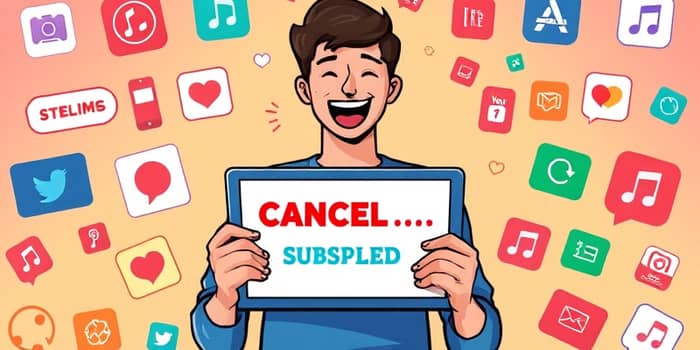Every month, countless dollars slip away unnoticed as subscriptions renew without a second thought. From video streaming and music services to memberships and specialty apps, these recurring charges add up. By taking intentional steps to audit and cancel unused subscriptions, you can reclaim hundreds of dollars each year and build healthier financial habits.
In this comprehensive guide, you’ll discover why subscription costs climb, how to uncover hidden fees, and the tools and strategies you need to streamline your spending. Let’s dive in.
Understanding Subscription Overload
Subscription services have revolutionized access to content and convenience. But the ease of signing up often leads to "subscription creep," where services accumulate faster than we can track. With the average adult paying for 5.4 subscriptions and spending nearly $1,080 per year, the stakes are high—especially when a quarter of that expense goes to unused or forgotten services.
Economic uncertainty pushes many to reassess spending. Over 60% of consumers now question their subscription bills, and more than a quarter have already canceled at least one service. The first step to saving is understanding exactly what you’re paying for.
Identifying Hidden Costs
Unused subscriptions often hide in plain sight. Charges blend into bank statements, loyalty bundles, and free trials that auto-renew. Gen Z loses up to $272 annually from forgotten services, and the average adult wastes $205 every year. These small leaks drain your budget.
To spot hidden costs, start with a thorough review of your statements. On average, Americans spend $90–$91 monthly on subscriptions, but when cell phone plans and other recurring fees are included, the number jumps to $273. By pinpointing unnecessary bills, you prepare to take control.
How to Identify and Cancel Unused Services
Once you know where to look, the next step is cancellation. Follow these steps to ensure you’re not paying for something you no longer use.
- Review bank and credit card statements for recurring payments you don’t recognize.
- Check app store accounts: Apple users go to Settings > Subscriptions, Android users open Google Play > Payments & subscriptions.
- Examine retailer memberships like Amazon Prime or Walmart+ under your profile settings.
- Use budgeting or subscription management apps to highlight recurring charges.
Once you’ve found unused services, cancel directly through the service’s website or app store. Under “Account” or “Membership” settings, look for a cancel or unsubscribe option. If the process is unclear, reach out to customer support or use the FTC’s “click to cancel” protections to make it easier.
Tools to Simplify Subscription Management
Managing subscriptions manually can feel overwhelming. Thankfully, a host of modern tools exist to automate and simplify the process. With powerful subscription management tools, you can track, manage, and cancel services in minutes rather than hours.
- Budgeting apps like Mint or YNAB identify recurring payments and alert you to increases.
- Dedicated services such as Rocket Money (formerly Truebill) and Trim scan accounts for subscriptions and can even submit cancellation requests.
- Banking apps increasingly include subscription trackers that show monthly patterns and warn of price hikes.
Adopting one or more of these tools will not only save time but also ensure you never lose track of a trial or renewal date again.
Building a Sustainable Subscription Strategy
Cancelling unused subscriptions is just the beginning. To maintain consistent savings, develop habits that prevent subscription overload from recurring:
- Set a quarterly calendar reminder to audit all recurring payments.
- Rotate services seasonally; cancel streaming during busier months and resubscribe when you have more leisure time.
- Consider family or group plans to share costs, reducing per-person expenses.
- Immediately cancel free trials if you’re unsure about long-term use.
By adopting these practices, you’ll create a lean, purposeful subscription portfolio that aligns with your lifestyle and budget.
Turning Savings into Financial Freedom
Imagine reallocating the $205 wasted by average consumers into an emergency fund, investing in skills, or paying down debt. These small monthly adjustments can ripple into substantial financial achievements over time.
What begins as a simple cleanup of digital bills transforms into streamlined financial habits that foster confidence and long-term prosperity. You’re not just saving money—you’re taking control of your future.
Start today by listing your active subscriptions, running a quick audit, and committing to one management tool. Within weeks, you’ll feel the empowerment of lower bills and a lighter financial load.
References
- https://www.ngpf.org/blog/question-of-the-day/question-of-the-day-how-much-does-the-average-consumer-spend-per-month-on-subscription-services/
- https://www.cnet.com/personal-finance/subscription-creep-is-real-consumers-are-paying-over-1000-each-year-cnet-survey-finds/
- https://www.self.inc/info/cost-of-unused-paid-subscriptions/
- https://bango.com/one-in-four-americans-spend-over-100-a-month-on-streaming-and-subscriptions/
- https://sellcoursesonline.com/subscription-economy-statistics
- https://www.cloudeagle.ai/blogs/subscription-management-tools
- https://www.engadget.com/apps/how-to-find-and-cancel-your-unused-subscriptions-130036314.html
- https://www.cnet.com/personal-finance/subscription-survey-2025/










